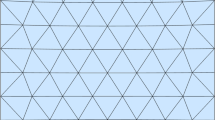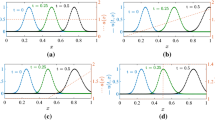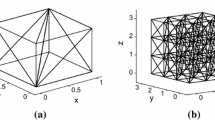Abstract
We examine the dispersion and dissipation properties of the P N P M schemes for linear wave propagation problems. P N P M scheme are based on P N discontinuous Galerkin base approximations augmented with a cell centered polynomial least-squares reconstruction from degree N up to the design polynomial degree M. This methodology can be seen as a generalized discretization framework, as cell centered high order finite volume schemes (N=0) and discontinuous Galerkin schemes (N=M) are included as special cases.
We show that with respect to the dispersion error, the pure discontinuous Galerkin variant gives typically the best accuracy for a defined number of points per wavelength. Regarding the dissipation behavior, combinations of N and M exist that result in slightly lower errors for a given resolution. An investigation of the influence of the stencil size on the accuracy of the scheme shows that the errors are smaller the smaller the stencil size for the reconstruction.




Similar content being viewed by others
References
Ainsworth, M.: Dispersive and dissipative behaviour of high order discontinuous Galerkin finite element methods. J. Comput. Phys. 198(1), 106–130 (2004)
Bassi, F., Rebay, S.: A high-order accurate discontinuous finite element method for the numerical solution of the compressible Navier-Stokes equations. J. Comput. Phys. 131, 267–279 (1997)
Dumbser, M.: Arbitrary High Order Schemes for the Solution of Hyperbolic Conservation Laws in Complex Domains. Shaker Verlag, Aachen (2005)
Dumbser, M., Balsara, D.S., Toro, E.F., Munz, C.-D.: A unified framework for the construction of one-step finite-volume and discontinuous Galerkin schemes on unstructured meshes. J. Comput. Phys. 227, 8209–8253 (2008)
Dumbser, M., Käser, M., Titarev, V.A., Toro, E.F.: Quadrature-free non-oscillatory finite volume schemes on unstructured meshes for nonlinear hyperbolic systems. J. Comput. Phys. 226, 204–243 (2007)
Dumbser, M., Munz, C.-D.: Arbitrary high order discontinuous Galerkin schemes. In: Cordier, S., Goudon, T., Gutnic, M., Sonnendrucker, E. (eds.) Numerical Methods for Hyperbolic and Kinetic Problems. IRMA Series in Mathematics and Theoretical Physics, pp. 295–333. EMS Publishing House, Zurich (2005)
Dumbser, M.: Arbitrary high order pnpm schemes on unstructured meshes for the compressible Navier-Stokes equations. Comput. Fluids 39(1), 60–76 (2010)
Hu, F.Q., Hussaini, M.Y., Rasetarinera, P.: An analysis of the discontinuous Galerkin method for wave propagation problems. J. Comput. Phys. 151(2), 921–946 (1999)
Lo, M., van Leer, B.: Analysis and implementation of recovery-based discontinuous Galerkin for diffusion. In: 19th AIAA Computational Fluid Dynamics Conference (AIAA-2009-3786), June (2009)
Luo, H., Luo, L., Nourgaliev, R., Mousseau, V.A., Dinh, N.: A reconstructed discontinuous Galerkin method for the compressible Navier-Stokes equations on arbitrary grids. J. Comput. Phys. 229(19), 6961–6978 (2010)
Park, H., Nourgaliev, R., Mousseau, V., Knoll, D.: Recovery discontinuous Galerkin Jacobian-free Newton Krylov method for all-speed flows. Tech. rep. inl/con-08- 13822, Idaho National Laboratory (2008)
Toro, E.F.: Riemann Solvers and Numerical Methods for Fluid Dynamics. Springer, Berlin (1999)
van Leer, B., Lo, M.: Unification of discontinuous Galerkin methods for advection and diffusion. In: 19th AIAA Computational Fluid Dynamics Conference (AIAA-2009-0400), June (2009)
van Leer, B., Lo, M., van Raalte, M.: Discontinuous Galerkin method for diffusion based on recovery. In: 18th AIAA Computational Fluid Dynamics Conference (AIAA-2007-4083), June (2007)
van Leer, B., Nomura, S.: Discontinuous Galerkin for diffusion. In: 17th AIAA Computational Fluid Dynamics Conference (AIAA-2005-5108), 6–9 June (2005)
van Raalte, M., van Leer, B.: Bilinear forms for the recovery-based discontinuous Galerkin method for the diffusion. Commun. Comput. Phys. 5, 683–693 (2009)
Acknowledgements
The author thanks the reviewers for their valuable comments. This project is kindly supported by the Deutsche Forschungsgemeinschaft (DFG) within SPP 1276: MetStroem and the research project IDIHOM within the European Research Framework Programme.
Author information
Authors and Affiliations
Corresponding author
Appendices
Appendix A: Dispersion Relation for the P N P M Schemes
In this section, the dispersion relation plots for all combinations of N and M up to 4 are shown. Furthermore, the accuracy results of all combinations for given points per wavelength and the resulting convergence error behavior are listed in Tables 12–19 (Figs. 5, 6, 7, 8, 9).
Appendix B: Dissipation Relation for the P N P M Schemes
In this section, the dissipation relation plots for all combinations of N and M up to 4 are shown. Furthermore, the accuracy results of all combinations for given points per wavelength and the resulting convergence error behavior are listed in Tables 20–27 (Figs. 10, 11, 12).
Rights and permissions
About this article
Cite this article
Gassner, G.J. An Analysis of the Dissipation and Dispersion Errors of the P N P M Schemes. J Sci Comput 54, 21–44 (2013). https://doi.org/10.1007/s10915-012-9600-0
Received:
Revised:
Accepted:
Published:
Issue Date:
DOI: https://doi.org/10.1007/s10915-012-9600-0












